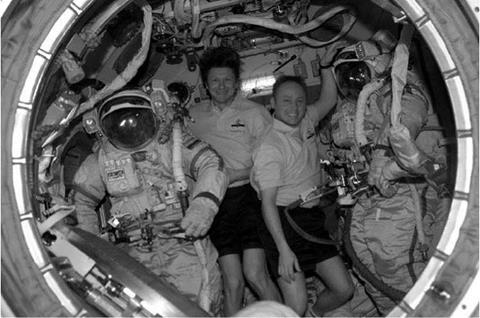EXPEDITION-9
Padalka and Fincke began their solo occupation of ISS with three days of light duties to help them get over the hectic hand-over week that had just passed. Padalka described his goals for the occupation as follows:
“The biggest goal for us as a crew is to keep the Space Station in operational condition and maintain the human presence aboard the Space Station because [the] last malfunction—I mean the situation with the leakage—showed us that if we had not had crew on board, we could have lost the Space Station.”
He added:
“We have the West science program, and currently about 40 experiments on behalf of the American side and the same number on behalf of the Russian side, are scheduled for us, and about 20 experiments for the European Space Agency… If we conduct all of the science program, if we can keep Space Station in operational condition, if we manage to perform scheduled spacewalks, if we keep our friendship with Mike, if we hand Space Station in operational condition to the next crew, in this case I would say that our mission was successful.”
The first week of May was spent carrying out a programme of Russian, American, and European biomedical experiments to determine how their bodies adapted to microgravity. They also completed maintenance on the battery chargers and the batteries in the American EMUs and the station’s EVA tools, as well as beginning a procedure to regenerate the canisters that would remove C02 in their exhaled breath from the EMUs. The EMUs had not been used for over a year. A second
|
Figure 45. Expedition-9: Gennady Padalka and E. Michael Fincke pose in the Pirs airlock with two Russian Orlan extravehicular activity suits. |
series of battery recharging took place at the beginning of the next week, while Fincke serviced the water-cooled underwear that would be worn under the EMUs. Both men also spent part of the week loading rubbish, including an Orlan EVA suit that was past its maintainable date, into Progress M1-11, which was scheduled for undocking on May 24. During the week American flight controllers up-linked new software to two multiplexer/demultiplexers and two S-0 ITS MDM computers, as part of a major programme to update the software on the station throughout 2004. The crew also installed the EarthKam in one of Zvezda’s windows on May 11, and performed biomedical experiments.
The Expedition-9 crew’s first month on ISS ended with a week of preparations for the Stage EVA to replace the CMG that had lost electrical power in April. The EVA was originally planned to take place on June 10, with both men wearing American EMUs and egressing from Quest. That changed on May 19, when they began a planned 7-hour check of the two pressure suits. Shortly after beginning the checks, Padalka reported that he had no circulation of cooling water in his EMU. Closer inspection revealed that the water held in the suit was bubbling and frothing. During the same tests Fincke’s EMU also suffered difficulties with its water-cooling system, caused by a sticking valve. On May 21 the water tank in Padalka’s EMU was drained and refilled. America admitted that only one of the three EMUs on ISS was operational. As a result, the EVA was delayed until June 16, and on that date both men would wear Russian Orlan suits and egress from Pirs. Russia would negotiate “compensation’’ for the use of their suits and consumables by having American astronauts spend additional hours working on Russian ISS experiments. The new plans complicated the EVA in that the astronauts would now exit Pirs and use one of the two Russian Strela cranes to reach the required area on the S-0 ITS, which was not as readily accessed from Pirs as from Quest. The two ISS Strela cranes had not been human-rated at that time, and the Russians were concerned for their capabilities. Also, the two men would be under Russian control while they exited the station and used the Strela to reach the junction between the Russian and American segments of ISS; once they were on the outside of the American sector and making their way to the S-0 ITS they would pass to American control. They would return to Russian control as they returned to the exterior of the Russian segment for their return to Pirs.
During the week, Progress M1-11’s thrusters were fired to raise the station’s altitude in preparation for the launch of Progress M-49. The burn also corrected the station’s orbital inclination, as NASA explained:
“Since the last inclination correction, about 3 years ago, [the] orbit inclination has decreased by approximately 0.01 degree, to a current value roughly mid-way between the ground rule range of 51.62 and 51.68 degrees. The lower limit would be approached in approximately 5 years, but doing part of the upward correction right now propellant is more efficiently used. Once the inclination is adjusted to the upper limit, no further inclination adjustments should be required for the remaining life of the ISS.’’
Progress M1-11 undocked from ISS at 05: 19, May 24, manoeuvred clear of the station, and entered a parking orbit. For the next 10 days the spacecraft was
monitored to see if future Progress vehicles could be used to support microgravity experiments, although no experiments were conducted on this occasion. Progress M1-11 was commanded to re-enter the atmosphere and burn up on June 3, 2004.











